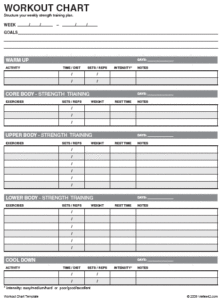Strength training is any training done in order to improve an athlete’s muscular strength. There are various training methods used by coaches and trainers in order to improve strength, you need to only know three (3): resistance training, weight training, and isometric training.
Much of this content has already been covered in Factors Affecting Performance, when you looked at how does training affect performance? and specifically looked at types of training and training methods – strength training. However, in Improving Performance, you are required to know this type of training and training methods in much more detail (note how in FAP strength training was a dash doing and here it is a dot point).
The syllabus states:
Students learn about:
- strength training
- resistance training, eg elastic, hydraulic
- weight training, eg plates, dumbbells
- isometric training
What you are required to do with strength training is also different from Factors Affecting Performance.
Students learn to:
- analyse TWO of the training types by drawing on current and reliable sources of information to:
Design a strength training program
Strength training programs are often designed using a table. The table has space for the: exercise, intensity or weight, repetitions (often repetition maximum or RM), sets, and rest periods. In the design of strength programs the principles of training should be used in order to ensure: the training methods best suit the sport, sports specific requirements and muscle groups are covered, muscular strength improves and results in improved performance.
How strength training adaptations can be measured
Strength training adaptations can be measured in a couple of ways. The best measure is a 1RM test. This is a test where the athlete lifts a weight once ONLY and cannot lift it a second time. This measure can be adapted for the various major and minor muscle groups and should increase with strength training.
Another test includes skin-fold testing and circumference measurements. These measurements are more specifically for measuring hypertrophy, but hypertrophy generally results in increases in muscular strength, making these measurements a valid measure of strength, but not as good as a 1RM test.
Safety in Strength Training
Strength training is generally a very safe form of training with injuries being very rare when proper precautions are taken. Training can become harmful if the muscles are not given 48 hrs of rest between work-outs. This can easily result in overuse injuries. Other important aspects include:
- always having a person to train with and to spot you when lifting weights
- perform each movement/activity with the correct technique (poor technique can result in injuries, particularly soft tissue injuries)
- training sessions should be designed and monitored by professionals (person trainer, coach, Exercise sport scientist etc)
- conducting the session in a professional manner (i.e. no competitions of who can lift the most etc)
Please note: although this video is ridiculous, the information being communicated is still correct.
Past HSC PDHPE Exam Questions (2012-2022)
2018 Question 31
(a) Explain both safe and potentially harmful training procedures related to TWO
training types. 8 marks
2019 Question 31
(a) (i) Describe TWO different types of training methods that are best suited to the performance requirements of an athlete in a particular sport. 4 marks
(ii) How can the training adaptations for the athlete identified in part (i) be measured and monitored? 4 marks

